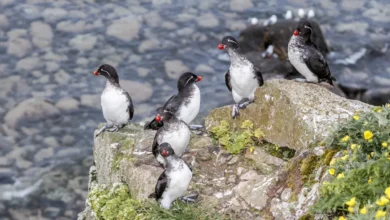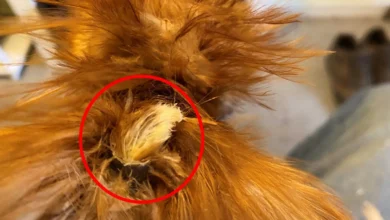Royal Parrot finches (Erythrura cyaneovirens regia) are endemic to Vanuatu, were they are commonly found at mid-altitudes (above 300 m) on the larger islands such as Espiritu Santo, as well as occurring on sea-level small islands.
They are usually seen along the edges of forests and grassland areas.
They tend to be shy and are usually seen alone, pairs or small groups feeding on figs in the forest canopy.
Description:
Size: The Royal Parrotfinch averages 11 cm in length.
Plumage:
Male Royal Parrotfinches have a bright red head and upper tail coverts. Their back is cobalt blue, changing into green as far as to the wings. They have a blue breast and turquoise-green upperparts.
The hen is identical to the male but she is a little duller in the neck and the breast.
Immature Royal Parrotfinches are duller and have a dull blue head. They attain their full color at 20 months.
Call / Vocalization:
They have a high, thin voice and trilling song.
Personality / Behavior:
These finches love water. One can frequently see them jump in and out of their bathing dishes. Bathing will take place a couple of times a day, summer or winter – and are an important part of their daily grooming.
Another characteristic of the parrotfinches is their almost semi-nocturnal nature. They are always last to roost at night, and can be seen still on the food station or darting around the aviary after dark. They are also the first to stir in the morning.
Aviculture:
Aviary Requirements:
This breed is totally vivacious, very energetic, and always on the move. They are very gentle, which makes them an ideal choice for a mixed, large and well-planted aviary. They need plenty of flight space.
A good aviary dimension would be 8ft. long x 7ft. wide. However, an aviary can never be too big for these active finches.
The two factors that seem to be very important for this finch species is the provision of a spacious aviary (more important than with other parrotfinch species) as well as the availability of figs to meet their dietary needs.
This parrotfinch species has been successfully bred in captivity and the incubation period and the independence age of the young is identical to that of the other members of the red-headed family.
The exception being that the young birds only obtain their full color at 20 months – while other parrotfinches obtain it at or before 12 months of age.
This tropical species needs to be protected from the elements. During the winter months, they need to have access to a heated shelter. The outside flight needs to have some draft protection.
One way would be to install slotted tracking on the sides of the aviary that will allow you to slide in either Perspex or Polycarb sheets during the winter months to keep out chilly winds and help keep some heat in.
Alternatively, such panels can be hung up along the sides – as long as they are firmly installed.
It is recommended to provide some cover within the aviary, which can be achieved by planting bushes suitable to your area, or alternatively putting up appropriate brush, which even when dry seems to provide cover adequate for their needs.
Over time the breed has adapted well to cooler climates. However, when purchasing birds from a breeder find out whether the breeder uses artificial heating sources. It takes time for birds to acclimatize to your local temperature and conditions.
The pair bonding of the adult birds is very strong, and in the aviary they are seldom seen apart. However, should either one die, a new partner should be introduced as soon as possible.
It is always advisable to have more hens in your colony than male birds, as it minimizes the potential conflict between males.
Having said all that, give them food, water, and nesting material, and they are likely to thrive and breed. If within your aviary, you have the facility to grow a seeding grass, then you are guaranteeing yourself a happy flock of parrot finches.
More Information about Captive Breeding
Breeding:
In their natural habitat breeding season starts in September with the building of a big nest of grasseshigh in the trees. In captivity the breeding season will be dictated by the climate and length of the days.
They usually produce clutches of 3-4 eggs which are incubated for about for 14 days. Two nests during a season are normal.
Diet:
In their natural habitat, they eat mainly a wide range of fruits, especially figs. This particular food item appears to be a crucial part of their diet.
A good-quality seed mix should be provided, as well as seeding grasses, various greens and live food – especially during the breeding season. They readily accept fresh fruits / veggies a lot, and greens such as parsley and dandelions. You can get a lot of free “green stuff” (safe, untreated plants please!) from your own garden to feed to them with.
Sprouted or germinated seeds are usually more easily accepted by “seed addicts” than fresh fruits and vegetables.
- Sprouted seeds are healthier as the sprouting changes and enhances the nutritional quality and value of seeds and grains. Sprouted seeds are lower in fat, as the process of sprouting utilizes the fat in the seed to start the growing process – thus reducing the fat stored in the seeds.
- Sprouted seeds will help balance your bird’s diet by adding a nutritious supply of high in vegetable proteins, vitamins, minerals, enzymes, and chlorophyll.
- Soaked and germinated “oil” seeds, like niger and rape seeds, are rich in protein and carbohydrates; while “starch” seeds, such as canary and millets, are rich in carbohydrates, but lower in protein.
- It is an invaluable food at all times; however, it is especially important for breeding or molting birds. Sprouted seeds also serve as a great rearing and weaning food as the softened shell is easier to break by chicks and gets them used to the texture of seeds.
While raising young, breeders often offer additional food items to the parents, such as hard-boiled eggs (potentially enriched with vitamins and minerals – if the diet is less than balanced), as well as sprouted seeds, and mealworms.
The fledglings readily accept live food, such as mealworms. They will take literally any size worm, and if too big to take at once, they will suck the pulp out of the worm.
Green food, on the other hand, takes them about two weeks before they accept it. But once they have gotten used to live food, their appetite is fairly insatiable.
Sprouted seed are readily accepted by birds and are highly nutritious. They make an excellent weaning food..
As with all other breeds, fresh water should be available at all times.
Specific Health Concerns:
Parrot finches spend most of the time on the ground foraging and are, therefore, susceptible to intestinal worms.
While some breeders state that these finches do not respond well to worming, others suggest the following protocol to address this health issue:
Mix 80 mils of water, 1.5 mils of Avitrol Plus, and 2.0 mils of strawberry topping. The strawberry topping seems to make it more palatable without affecting the efficacy of product.
In most cases, 3 or 4 times a year seems appropriate, particularly if you are feeding live food. However, use your own judgment on whether or how often to administer.
Whether or not such a worming routine is advisable for your own birds should be discussed with your avian vet.



